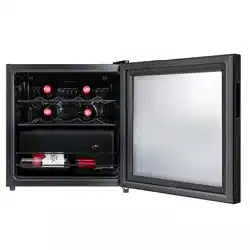Documents: Go to download!
- Owner's manual - (English, French)
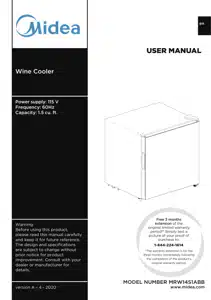
- WINE COOLER SAFETY
- IMPORTANT SAFETY INSTRUCTIONS
- PROPER USE OF THE COOLER
- MAINTENANCE OF THE COOLER
- Disconnect the cooler
- Stop using the cooler
- Clean the cooler
- TROUBLE SHOOTING
Table of contents
USER MANUAL Wine Cooler
WINE COOLER SAFETY
YOUR SAFETY AND THE SAFETY OF OTHERS ARE VERY IMPORTANT
To prevent injury to the user or other people and property damage, the instructions shown here must be followed. Incorrect operation due to ignoring of instructions may cause harm or damage, including death.
The level of risk is shown by the following indications.
 This symbol indicates the possibility of death or serious injury.
This symbol indicates the possibility of death or serious injury.
 This symbol indicates the possibility of injury or damage to property.
This symbol indicates the possibility of injury or damage to property.
 This symbol indicates the possibility of dangerous voltage constituting a risk of electrical shock is present that could result in death or serious injury
This symbol indicates the possibility of dangerous voltage constituting a risk of electrical shock is present that could result in death or serious injury
IMPORTANT SAFETY INSTRUCTIONS
WARNING
GENERAL APPLIANCE SAFETY
- Read all safety warnings, instructions, illustrations and specifications provided with this appliance. Failure to follow all instructions listed below may result in electric shock, fire and/or serious injury.
- Save all warnings and instructions for future reference
ELECTRICAL SAFETY
- Plug into a grounded 3 prong outfit.
- Do not remove ground plug.
- Do not use an adapter.
- Unplug the power cord by holding the plug, never by pulling the cord.
- DO NOT turn the applianc by plugging or unplugging the power cord.
- DO NOT use an extension cord.
- Unplug the cooler before cleaning or defrosting.
Grounding requirement
- This cooler must be grounded. This cooler is equipped with a grounding plug. The plug must be inserted into an outlet that is properly installed and grounded.
- Improper use of the grounding plug can result in a risk of electric shock. Consult a qualified electrician or service person if the grounding instructions are not completely understood or if doubt exists as to whether the cooler is properly grounded.
LOCATION SAFETY
- This cooler is intended to be used in household and similar environments.
- Install in accordance with the manufacturer’s instructions.
- This cooler should not be recessed or built-in an enclosed cabinet. It is designed for freestanding installation only. WARNING - Keep ventilation openings, in the cooler, clear of obstruction.
- DO NOT install near any heat sources, such as radiators, heat registers, stoves, other cooking appliances or in direct sunlight.
- DO NOT store or use gasoline or any flammable liquids inside or in the vicinity of this cooler.
USE AND CARE SAFETY
- Flammable refrigerant used. Follow handling instructions carefully. Risk of fire or explosion due to puncture of refrigerant tubing.
- Flammable refrigerant used. Do not use mechanical devices to defrost cooler. Do not puncture refrigerant tubing.
- Do not place heavy objects or other appliances such as microwave ovens, toasters etc. on the lid of the cooler.
- This appliance is not intended for use by persons (including children) with reduced physical, sensory or mental capabilities, or lack of experience and knowledge, unless they have been given supervision or instruction concerning use of the appliance by a person responsible for their safety.
- Children should be supervised to ensure that they DO NOT play with the appliance.
- DO NOT touch the interior of the cooler with wet hands. This could result in frostbite.
- Clean only with a damp cloth. Use nonflammable cleaner.
SERVICE SAFETY
- Disconnect power before servicing.
- Flammable refrigerant used. To be repaired only by trained service personnel. Do NOT puncture refrigerant tubing.
- Refer all servicing to qualified service personnel. Do not repair or replace any part of this appliance unless specifically recommended in this manual. Servicing is required when the appliance has been damaged in any way, such as the power supply cord or plug is damaged, liquid has been spilled or objects have fallen into the appliance, the appliance has been exposed to rain or moisture, does not operate normally, or has been dropped.
- If the supply cord is damaged, it must be replaced by the manufacturer, its service agent, or similarly qualified person, in order to avoid a hazard.
- If component part is damaged, it must be replaced by the manufacturer, its service agent or similarly qualified persons in order to avoid a hazard.
- Replace all parts and panels before operating.
PROPER DISPOSAL
WARNING: Suffocation Hazard Before you throw away your old cooler:
- Remove the door or lid so that children cannot hide or get trapped inside your old appliance.
- Leave any shelves in place so that children may not easily climb inside.
- Failure to follow these instructions can result in death or brain damage.
IMPORTANT: Flammable gas and refrigerant used. It is the consumer’s responsibility to comply with Federal and Local regulations when disposing of this product. Refrigerants must be evacuated by a licensed, EPA certified refrigerant technician in accordance with established procedures.
PROPER USE OF THE COOLER
Names of components
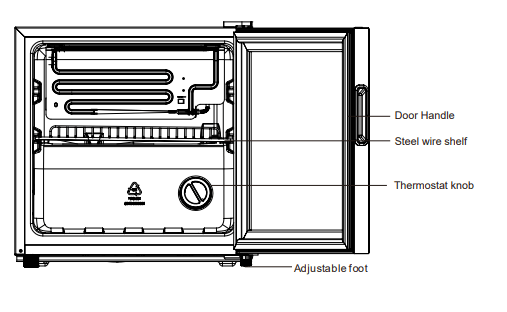
(The picture above is only for reference. The actual configuration will depend on the physical product or statement by the distributor)
- The temperature in the cooler is 5-18℃ , only used to store unopened bottled wine (red wine, white wine, rose wine).
- Do not place food in the cooler to prevent bacterial contamination.
- Please keep the interior of the wine cabinet dry, please drink Bottled wine during the validity period.
Temperature Control
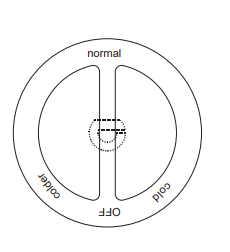
After power on the cooler,it can turn the thermostat knob to set the inside temperature level,
- "Cold" is the warmest setting.
- "Colder" is the coldest setting.
- "OFF" means stop cooling.
The setting range of centigrade temperature is 5℃-18℃ and the setting range of Fahrenheit temperature is 41 - 64
Placement
- Before using the cooler, remove all packaging materials including bottom cushions and foam pads and tapes inside the cooler, tear off the protective film on the door and the cooler body.

- Avoid direct sunlight and heat sources such as stove, heating radiator, etc.

- The cooler is placed in a wellventilated indoor place; the ground shall be flat, and sturdy (rotate left or right to adjust the feet for levelling if unstable).
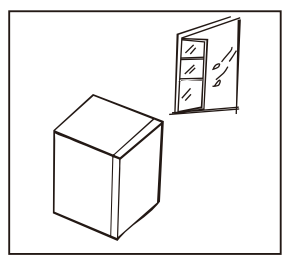
- The top space of the cooler shall be greater than 30cm,and the distances from bothsides and backside shall be more than 10cm to facilitate heat dissipation.

Start to use
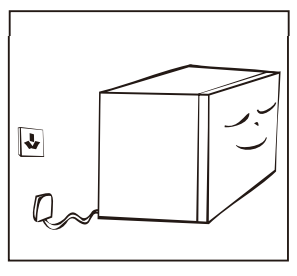
- The cooler shall stay for half an hour before connecting power when it is firstly started.
- Clean up the inner chamber before put into use for first time .
- Do not connect cooler to electronic energy saving plug and converter that can convert DC into AC (E.g.: solar energy system, ship grid).
- Water drop or frost will be generated on when compressorbacksideofcooler is running, which is decided by function of cooler. wiping outfrostor waterdropis notneeded as the back will wipe them out automatically. The defrosted water will be collected into drain tank, then inflow into water disposal pan above the compressorand vaporized.
Energy saving tips
- The Cooler shall be placed in room dry and ventilated. The cooler cannot be put under direct sunlight or next to hear source (such as radiator. stove. etc.) and a suitable insulation board shall be applied if necessary.
- Try to shorten opening time of cooler’s door.
The arrangement of bottle
- Do not let bottle touch the backside of cooler in order to maintain good air circulation in the cooler.
- The bottle number here may be different from bottles in different shape and size.
- The capacity for bottle storage in the wine cabinet is based on the following marked bottle size. Oversized bottle may have impact on the number of bottle storage in the wine cabinet.

Practical skills for grape wine’s storage
- Do not store bottled wine by box or case in refrigerator.
- The cork of the old bottles hall always be soaked in the wine when putting in to cooler. Airspaceis not allowed between wine and cork
- Open-type bottle shelf is helpful, as it does not cut off air circulation. The air moisture that condensed on bottle can be dried out swiftly.
- The wine shall before drinking: Such as put pink red wine onto the table 2-5 hours before drinking and red wine 4-5 hours, then can reach suitable serving temp. White wine, on the contrary. can be served right on the table.
- Champagne shall always be stored in cooler and taken out only before drinking.
- Please notice that wine's temperature is always lower than ideal serving temp. as the temperature will immediately rise 1 to 2°C when pouring into tumbler.
Serving temperature
The wine's taste depends on right pouring temperature; therefore it determines its flavor. We suggests the wine's temperature reaches the following degree when pouring:
- Bordeaux red: 18°C
- Louis Family dry red wine/Barolo: 17°C
- Burgundy red/Bordeaux red: 16°C
- Port: 15°C
- Young Burgundy red: 14°C
- Young red wine: 12°C
- Young Beaujolais/all white wines with little residual sugar: 11°C
- Old white wines/Chardonnay: 10°C
- Sherry: 9°C
- Young white wines from late vintage: 8°C
- White wines Loire/Entre-deux-Mers: 7°C
MAINTENANCE OF THE COOLER
Disconnect the cooler
-
Unplug power plug to disconnect the cooler.
Stop using the cooler
If the cooler left unused for a long time, please:
- Unplug the cooler;
- Clean the cooler;
- Keep the cooler door open.
Clean the cooler
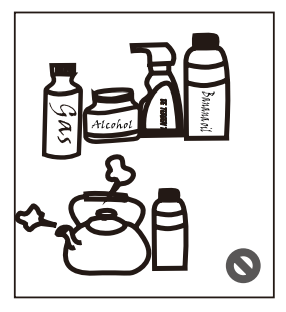
- Dusts behind the cooler and on the ground shall be timely eaned to improve the cooling effect and energy saving.
- Check the door gasket regularly to make sure there are no debris.
- Clean the door gasket with a soft cloth dampened with soapy water or diluted detergent.
- The interior of the cooler should be cleaned regularly to avoiddor odor.
- Please turn off the power before cleaning, remove drinks ,shelves, etc.
- Use a soft cloth or sponge to clean the inside of the cooler, with two tablespoons of baking soda and a quart of warm water. Then rinse with water and dry with a soft cloth. After cleaning, open the door and let it dry naturally before turning on the power.
- For areas that are difficult to clean in the cooler (such as narrow sandwiches, gaps or corners), it is recommended to wipe them regularly with a soft rag, soft brush, etc. and when necessary, combined with some auxiliary tools (such as thin sticks) to ensure no contaminants or bacterials accumulation in these areas.
- Do not use soap, detergent, scrub powder, spray cleaner, etc., as these may cause odors in the interior of the cooler or contaminate food.
- Clean the shelves with a soft cloth dampened with soapy water or diluted detergent. Then rinse with water and dry with a soft cloth or dry naturally.
- The wooden wine rack should not be directly immersed in liquid to prevent cracking or mold after moisture. The wooden wine rack is cleaned with a dry soft cloth. The heavily contaminated wooden wine rack should be cleaned with a soft cloth that has been wrung out, and dry naturally.
- Wipe the outer surface of the cooler with a soft cloth dampened with soap water, detergent, etc., and then wipe dry. Do not rub or scratch the surface of the glass door to prevent the door from being broken or scratched.
- Do not use hard brushes, clean steel balls, wire brushes, abrasives(such as toothpastes), organic solvents (such as alcohol, acetone, banana oil, etc.), boiling water, acid or alkaline items, which may damage the cooler surface and interior. Boiling water and organic solvents such as benzene may deform or damage plastic parts.
- Do not rinse directly with water or other liquids during cleaning to avoid short circuits or affect electrical insulation after immersion.Water should not soak the operating control elements and lighting system on the glass door.
Notice: Do not use detergent and solvent with sand or acid.
TROUBLE SHOOTING
1. Inoperation
- Whether the cooler is plugged and connected to power; Low voltage;Whether temperature control knob is in the work area; Failure power or tripping circuit.
2. Long-term operation of compressor
- It is normal that cooler operates for longer time in summer when the ambient temperature is higher; Do not put too much beverage s in the cooler at one time; Frequent opening of cooler door.
3. Illuminating light does not shine
- Whether the cooler is connected to power, whether the indicator light is damaged.
4. Loud noises
- Whether the floor is flat, whether the placement of cooler is stable; Whether the cooler accessories are properly placed
5. Cooler enclosure heat Condensation
- The cooler enclosure may emit heat during running specially in summer, this is caused by the radiation of the condenser, and it is a normal phenomenon.
- Condensation: condensation phenomenon will be detected on the exterior surface and door seals of the cooler when the ambient humidity is high, this is a normal phenomenon, and after wiping with towel, turns up the set temperature of the appliance properly.
6. Airflow sound Buzz Clatter
- Refrigerants circulating in the refrigerant lines will produce eruption of sound and grunts which is normal does not affect the cooling effect.Buzz will be generated by running compressor specially when starting up or shutting down. The solenoid valve or electric switch valve will clatter which is a normal phenomenon and does not affect the operation.
See other models: MT18DDSCR1RCM MLE60T7AGS MLH60T7AGS MLE45N1BWWC MLV45N1BWWC
